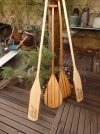Rob Stevens
Wooden Canoes are in the Blood
Here is Marc Ornstein's latest article on silent paddling, for wildlife observation and photography.
It complements his previous article on in-water recovery technique (link included);
It complements his previous article on in-water recovery technique (link included);

